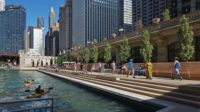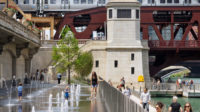Interview with Carol Ross Barney

Carol Ross Barney. Photo © Tara White
Architects & Firms
With a portfolio of train stations, chiller plants, and border stations, Carol Ross Barney has built one of the nation’s most vital practices, from utilitarian public infrastructure that seldom gets the attention of a designer. But these pieces of urban connective tissue, expanding outward from her home base in Chicago—where she founded her firm, Ross Barney Architects, in 1981—are not, in her hands, unassuming. Her Chicago Riverwalk (on which she collaborated with Sasaki) synthesizes landscape design and architecture to create an engaging pedestrian corridor along Chicago’s founding waterway, generating a new civic connection to the water.
In response to the pandemic crisis and last year’s uprisings against racist police violence, demands for equitable public space are reshaping conversations around this sort of infrastructure, just as the horizon of what’s politically possible opens up a pathway toward more investment in cities and towns. By selecting Ross Barney for the Cooper Hewitt, Smithsonian Design Museum’s 2021 National Design Award for Architecture and Interior Design, the institution honors a designer who has found ways for the prosaic and noble to hold us together. The architect spoke with Zach Mortice for RECORD.
Why did you decide to build your practice around public sector projects?
I started out thinking that design will make a difference. As a kid, there were spaces that impressed me, that made my emotions change, and I was really aware of that power. I wanted to do that. But I had two epiphanies. One was that public space has a much bigger impact than other spaces. If you’re going to make everyday life better, why not do it in public? The second was that I’ve always felt empowered working in the public realm, because I see myself as a part of a community, and that makes me not only the designer but the client.
With my first partner, Jim Jankowski, we made a pact that we would rather do toilet rooms and parking lots than houses for our friends, not that we had bad friends. We think this is more important.
How has Covid-19, which has separated us in many architectural contexts, made us reevaluate the value of the public sector?
The pandemic has forced us to consider our commonly owned and operated public spaces in a new light. Now the space is so precious, and people are thinking about who owns it and why. In a way, that’s the essential argument that Americans are having with each other. What’s your responsibility to the whole? Can you be unvaccinated and be responsible? Is there morality in that type of individualism? And that extends to space. Why don’t we have green space for everybody? It’s forced a conversation about the health and well-being of the community, and our individual roles in it.
When you were selected for the Cooper Hewitt award, did it seem that appreciation for the public sector work you’ve steadily championed has finally risen to match the crises facing the public realm?
We’re not the Cooper Hewitt’s usual audience at all. We’re almost urban guerrillas. We don’t have a building specialty—we’re really interested in a lot of different situations. What they have in common is that they need some sort of intervention, and they’re not always thought of as opportunities for design. It’s hard to run a studio like that, believe me, although it’s been very satisfying. It’s willful. You do what you want.


